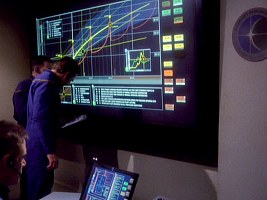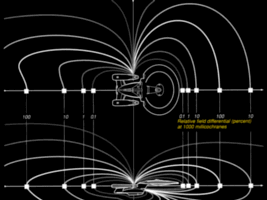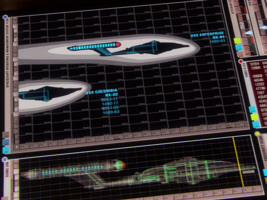3 Subspace (Draft)
The Physics and Technology of Warp Propulsion
3.1 What is Subspace?3.2 Subspace Models3.3 Subspace Fields and Warp Fields3.4 Subspace Technology3.5 Subspace Phenomena
3.1 What is Subspace?
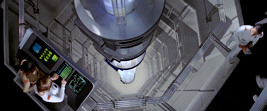
Preliminary remark
Subspace as shown in Star Trek does not exist in present-day physics as a reality or only a theory. It is a concept of storytelling. Subspace is necessary because FTL travel is impossible within the boundaries of special relativity as outlined in Chapter 1.2. Being part of a fictional universe, subspace has not been developed by far as consequently as a truly scientific idea would have required. On the contrary, everything we know about subspace is based on more or less random and often contradictory canon evidence.
A Google search for "subspace" gives us more than 90% Trek-related results. Most of the rest refers to concepts where a subspace is a subset to a space in a mathematical sense. In other words, the real subspace is a generic mathematical model, whereas Trek's subspace denotes a specific physical concept. The equal naming is nothing more than a coincidence.
Much of the following is speculation and not strictly based on observations, but it is conceived to comply with them. Some prominent subspace characteristics and phenomena will be made more plausible. Still, some contradictory evidence may remain simply because subspace was never meant to represent a scientific theory.
Definition
There is no canon definition of what subspace actually is. But there are countless canon accounts on subspace that allow to make a couple of presuppositions.
1. Subspace must be present everywhere in the universe because sensors can measure subspace distortions wherever deemed necessary. So it looks like for every point in our space there is a corresponding point in subspace, otherwise the various measurements of subspace stress in a certain region of space and of the warp field (which obviously has a spatially limited effect on subspace) would make no sense.
2. It appears that subspace is a continuum in addition to and outside of the three dimensions of our normal space and to time. Subspace may be described as a dimension, and there would be plenty of them left in present-day string theories that subspace could represent. But it is most likely not equivalent to a fourth spatial dimension, since it exhibits considerably different characteristics than the three familiar dimensions. Submerging into subspace is not like moving in normal space. This specialty of subspace is not unlike the dimension of time. Time is not equivalent to spatial coordinates either, since "time's arrow" dictates a preferred direction. Consequently, we would not expect subspace "distances" to be measured in meters (and not in seconds either).
3. Transitions of matter or energy into subspace or, vice versa, from subspace into real space might occur naturally. Subspace itself or domains accessible only through subspace are even believed to be populated by indigenous lifeforms (see 3.5 Subspace Phenomena). It really exists as a physical domain and not just as a mathematical model illustrating the effects of FTL propulsion.
4. Still, the presence of subspace as depicted in Star Trek is beyond human perception as long as we are confined to our space-time, and it can only be verified with special measuring equipment of the future. The frequent light effects connected with subspace may be explained away in that they are secondary effects in our space, which are typical of, but not a definite indicator of the presence of a subspace phenomenon. In other words, present-day equipment wouldn't detect anything outlandish about subspace light effects, because it's just light. Only that we may not be able to explain where it comes from and why without the knowledge of subspace.
Subspace vs. hyperspace
"Hyperspace" is another term frequently used in science fiction. It seems that most science fiction is using a concept of folded space for FTL travel, bringing two points in space closer together in a higher dimension - hyperspace. This common idea of hyperspace is much the same as the concept of wormholes which are commonplace in Star Trek too. It is quite obvious that subspace in Star Trek is supposed to be something different - not only quantitatively (Star Trek ships with warp drive are considerably slower than if they were passing through a wormhole), but also qualitatively (ships at warp always remain practically in our space-time, whereas wormhole/hyperspace travelers definitely don't). Hyperspace was only mentioned very few times in Star Trek, and mostly by accident like a few times on TNG. We wouldn't expect the two domains to be identical, and they have different (even opposite) names. So where "hyperspace" was used like "subspace" on screen, we should either imagine that the characters actually said "subspace" (the convenient solution) or assume that they were really talking about something different, much less common than subspace.
3.2 Subspace Models
Premise
We assume that subspace is a physical reality, an inhabitable realm and not just a mathematical model. Yet, in both cases we would have to describe how subspace could look like from the inside and how it could relate to real space. This chapter attempts to create a theoretical foundation for everything that we know about the structure of subspace from canon accounts.
Side note Many of the considerations about the structure of subspace are based on Christian Rühl's excellent Subspace Manual at Star Trek Dimension [Rüh].
Continuous vs. discrete model
Fig. 3.1 depicts a three-dimensional representation of the four-dimensional combination of space (x,y,z) and subspace (zeta). The model on the left is continuous, the one on the right exhibits distinct layers of subspace. In both models our three-dimensional space is just a part of a whole which we may call subspace. Only the two dimensions x and y of normal space are shown. The third axis with the coordinate zeta is what we can call the "subspace depth" which, as mentioned above, probably isn't measured in meters or other length units because subspace is not akin to a spatial dimension. In TNG: "Schisms" Geordi identified Riker's homing signal as coming from an energy level of 16.2 keV, which indicates that the scale of "subspace depth" may be an energy scale.

Fig. 3.1 Continuous (left) and discrete (right) subspace model
In the continuous model (Fig. 3.1 left) our normal space encompasses just the very surface (x,y,zeta=0) of a subspace continuum. Zeta is continuous just like x and y too and may assume any positive real value, while zeta<0 remains undefined. Any point in the x-y plane has an infinite number of corresponding points in subspace along the zeta-axis. This is the model we are likely to apply as a first approach, assuming that x,y,z as well as time are continuous (at least to our perception and within the accuracy of conventional measuring equipment), and that there would be no reason why the same should not apply to subspace. But this model may turn out flawed.
The discrete model (Fig. 3.1 right) may work better to describe the expected as well as the observed properties of subspace. In this model, there is no continuous "subspace depth" zeta any longer. Instead of that, subspace is divided into discrete layers which I have given tentative numbers k starting with "0". Within each layer, the properties of subspace are changing only slightly or are even constant, whereas the properties in zeta direction are a step function, creating some sort of barrier between each two adjacent layers. We may imagine that considerably more energy has to be expended to move from one layer to the next one than inside the same layer. The bright green uppermost layer numbered with "0" is identical to normal space.
Side note The concept of energy barriers is quite common in solid-state physics and particularly important to describe semiconductors. Any solitary atom exhibits discrete energy levels. In an extended solid-state material, these energy levels join to bands which are continuous in x,y,z and allow spatial charge transport if the band is not already fully occupied. There are band gaps which are not allowed to be occupied by charge carriers. In order to make the transition from one band to a higher (and emptier) one, it is necessary to supply a sufficient energy in the form of light, voltage or heat, corresponding to the width of the band gap.
Coming back to the continuous approach, in this model normal space would have to occupy a "thickness" of exactly zero. This seems possible in a perfect world. But realistically, there would have to be natural fluctuations ("zero-point energy"). Anyone or anything in our world would not always be exactly in real space, but slightly submerged into subspace. Perhaps this natural fluctuation is small enough to evade our senses, and it may have influenced any physical experiments prior to the discovery of subspace only below the measurement limit, so it remained unnoticed. Still, there is the problem that the subspace axis extends only in one direction, that there are supposed to be no negative values. As a result, the average of all fluctuations of normal space could not be found at zeta=0, but at a small subspace depth zeta>0. In other words, the actual normal space as found by measurements would not be equal to the theoretical normal space at the very surface of the continuum. It may be suggested that negative subspace is actually identical to hyperspace, but we would expect hyperspace to have completely different properties which may not be explained with a simple sign reversal. Summarizing, using a discrete model, it is much easier to explain why subspace is not within the limits of our perception and measuring equipment, the reason being that first a threshold has to be crossed to become aware of the existence of subspace. Some sort of exotic energy is required in considerable amounts to that end, energy which naturally exists because of quantum fluctuations only in minute amounts.
The second flaw of the continuous approach is more straightforward. We know that there are peak transitional thresholds between the familiar warp factors at which the energy expenditure rises strongly. More precisely, these thresholds even define the warp factors, as a look at the official diagram from the TNG Technical Manual [Ste91] reveals (part of it was clearly visible on screen in ENT: "First Flight" too). It seems logical that this observation is attributed to the structure of subspace. In other words, the peak transitional thresholds most likely exist due to transitions from one subspace layer to another. Alternatively, the peak transitional thresholds might reflect just the technical principle of the ship's engines, but in this case the the scale would be far less universal. It would change too often following progress in propulsion technology, and the warp factors would depend on the ship class, maybe even on how the drive is tuned on an individual ship.
In addition, we have evidence from TNG: "Schisms" that the aliens' inhabitable domain is located in a "tertiary subspace manifold", which sounds very much like subspace consists of discrete layers. Geordi also mentions "subspace bands" in the episode, but just like radio frequency bands these may be defined more or less arbitrarily even in a continuous subspace model.
Inside subspace
Having decided that subspace most likely has a discrete structure, it needs to be clarified what is the difference between the single subspace layers. The first assumption is that subspace layer 1 should be "somewhere else" than the normal space layer 0, as seen most obviously in TNG: "Schisms" where crew members were abducted into subspace by aliens. The realm shown in the episode looked much like our normal space, but was obviously not present in normal space at any place x,y,z or any time t (it was explicitly mentioned in the episode to be a "tertiary subspace manifold/domain"). Although we cannot be sure whether the alien realms in "Schisms" as well as in VOY: "Heroes and Demons" or VOY: "Bride of Chaotica" are not actually already in a parallel space/universe (see Fig. 3.5), there should be some inhabitable place "inside subspace" too if there is something like that on either side of it. In other words, if subspace is always talked about like an extended domain, why should it be only some sort of uninhabitable gate between the universes in reality?
There must be some sort of difference between the single layers. Regardless of the nature of this difference, we may imagine that subspace differs the more from normal space the further "below" the layer is located. We may say that subspace should become the more "exotic" the deeper we submerge into it. It is just speculation, but we may think of a model in which the subspace layers form some sort of funnel. In Fig. 3.1 we could see that each point in normal space-time (with just the x-y plane depicted) corresponds with one point at a given "depth" zeta (continuous) or k (discrete), still assuming that subspace has the same "lateral" geometry (in x-y) as normal space. Fig. 3.4 illustrates how a region in normal space could be related to gradually denser subspace layers. This compression could be the key to warp propulsion, transwarp and FTL communication, considering that the distances to be bridged in subspace in a given time shrink with respect to normal space! This way subspace can be a shortcut through space.

Fig. 3.4 Model of gradually compressed subspace
Unlike it is the case with wormholes or with some of the natural or artificial anomalies discussed below, these funnels are just illustrations of how subspace relates to normal space. They are no dedicated gates. Subspace is usually "flat" in a similar fashion as normal space-time is homogenous, at least in the absence of a mass that could distort it, according to general relativity. In a "flat" subspace one could draw such a funnel for each possible square unit in the x-y plane. Also, no starship entering subspace would "fall" into such a funnel. On the contrary, seeing how the layers are likely separated by energy barriers or peak transitional thresholds, they could much easier move within one plane than between the planes.
The far end
We may go one step further and ponder where the bottom of subspace is located, and if the funnels ends up in a singularity, a depth in which all the reference points to our universe merge to one single point. In such a singularity space would be concentrated much like mass is concentrated in a single point in a mathematical model of a black hole. This is the point that Tom Paris would have arrived at in VOY: "Threshold" if we believe the fairy-tale of "infinite speed". But what if subspace actually doesn't reach down to such a singularity, if after passing a number of compressed layers its density drops again? This would be equivalent to approaching normal space again, yet on the "other side" of subspace. Passing through all subspace layers may take us to a parallel universe! This idea is illustrated in Fig. 3.5. It is undetermined how many parallel universes exist and which funnel leads to which universe. It may depend on when and how the parallel universe came to life. But basically it would be possible to have just one parallel universe like the one of TOS: "Mirror, Mirror", as well as an immense number like in TNG: "Parallels".
Evidence for the existence of parallel universes accessible through subspace can be found in DS9: "Playing God" where the protouniverse started off as a subspace phenomenon. The strange realms within subspace where fantasy becomes reality, like in TNG: "Where No One Has Gone Before" and "Remember Me", and perhaps also the aliens' inhabitable domain in "Schisms" may be well regarded as either deep in subspace or already beyond the far end of subspace.
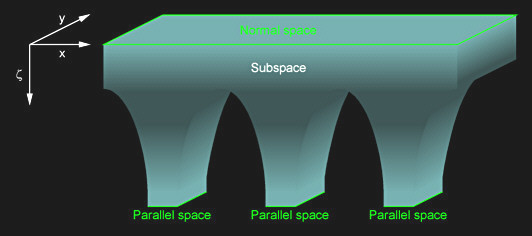
Fig. 3.5 Relative subspace model [Rüh]
Now we have to do just one more thing. We need to translate the "geocentric" model in Fig. 3.5 which arrogantly puts our universe above everything else to an absolute model in which our universe is just one among many others. This is shown in Fig. 3.6 where the irregularity is intentional to demonstrate that universes embedded into a subspace substrate may be regarded like galaxies inside the dimensions of space.
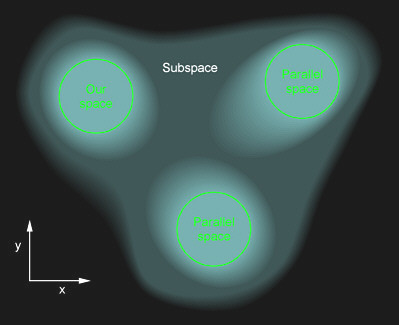
Fig. 3.6 Absolute subspace model [Rüh]
3.3 Subspace Fields and Warp Fields
Premise
Subspace is the domain which enables warp propulsion, at least in the type of warp drive used on Federation starships and those of most known races in Star Trek. We know from many statements in episodes that the warp engine generates a warp field that totally encompasses the starship. The warp field corresponds to a distortion of subspace. The subspace field stress is the defining quantity of a subspace or warp field and is measured in cochranes. At a field stress of more than 1 cochrane we obtain a warp field which, with the right frequency and geometry tuning, may become a propulsive asymmetric warp field, as outlined in the TNG Technical Manual [Ste91]. TheTNGTM describes such a warp field as a combination of different nested layers, "each layer exerting a controlled amount of force against its next-outermost neighbor." This coupling of nested layers which correspond to different frames of reference can be supposed to enable FTL speeds because between each two layers the effective relative speed would remain below c. Still, with no more than 9 layers the attainable speed could be no more than 9c. Star Trek's warp drive circumvents the limitations of special relativity, but there must be something special about subspace as a frame of reference in addition. As outlined in the previous chapter, one idea is that the structure of subspace may be such that corresponding points in space are closer together in subspace.
Side note A more elaborate and in several ways different treatise on the nature of subspace fields is Subspace Physics [Hin2] at Jason Hinson's site.
In order to achieve superluminal speeds, would the ship itself have to submerge into subspace and hence into a separate domain, like it is with (hyperspace) jump gates or with wormholes? Not necessarily. The term "subspace field" itself, as well as the fact that the ship is not visibly in a different realm during normal warp travel indicate that it may still be in normal space. Conversely, with the various transwarp drives or slipstream that could be seen especially during TNG and Voyager the ship always appeared to be in some sort of tunnel through space which would have to be similar with normal warp propulsion if it took place inside subspace. Additionally we know from TNG: "Where No One Has Gone Before", "Schisms" and other occasions that subspace is a realm that is inhabitable but that ought to look in some way different than normal space. Hence, it seems more likely that the a ship using normal warp drive remains in our space. In this sense a subspace field is not a field that opens a gate into subspace, but rather one that allows subspace to "flow" into our space, making it more like subspace or shielding it against our space like some sort of semi-permeable wall.
Subspace field
A subspace field below 1 cochrane is a distortion of normal space for the most part, so we may want to call it just a "space field" (but since subspace includes space, the collective name "subspace field" is definitely correct). The field is not strong enough to stretch down to the first layer of subspace. But it has the effect of lowering the apparent mass of the ship as observed from outside because of its special geometry. This effect of a subspace field would be much the same if the ship were amidst the distortion, but the stress would kill the crew and ultimately destroy the ship at above a few hundred millicochranes. Instead of exposing the crew and spaceframe to such a stress, all subspace fields, also and especially those above 1 cochrane, are created in a way that a shell of high distortion envelops the ship which is safe in a largely undistorted interior, as can be seen in Fig. 3.7.
The mass-lowering property of subspace fields is used in the impulse engines to facilitate sublight propulsion through subspace driver coils in the impulse engines as stated in the TNGTM. Once back in normal space, the exhausted plasma from the impulse engines gain mass and because of the principle of momentum conservation the thrust increases accordingly -- the ship may have less powerful impulse engines and needs to carry less fuel. For warp, on the other hand, it may be just a beneficial side effect. The mass would have to be lowered to zero to be able to reach light speed, which is impossible with any field of limited energy content, even a warp field of above 1 cochrane.
Fig. 3.2 shows the power expenditure of a typical warp drive. If we look at the first peak transitional threshold at Warp 1, we find that the power rises strongly as the speed approaches the particular threshold which is exactly at the speed of light, c. The power peak is almost two decades high, but clearly not infinite. If, however, the mass can't be lowered to zero, how can the threshold be passed with finite energy? The reason must lie in some limited interaction of the subspace field below 1 cochrane with the first subspace layer. While there may be no open gate that would allow energy to flow into subspace or subspace to flow into normal space, some tunneling may occur between the two, considering that the space distortion lowers the threshold between the two domains. Any subspace or warp field does the same in any other layer of subspace.
Symmetric warp field
A symmetric warp field is a subspace field strong enough to shield a ship from normal space in a way that it takes on the frame of reference of subspace, while the ship itself is still in normal space. In order to become a warp field, the subspace stress has to be more than 1 cochrane. At 1 cochrane the field created by the subspace coils in normal space is strong enough to cross the threshold to the first subspace layer. Vice versa, subspace begins to flow into normal space. This subspace begins to "fill" the spatial distortion shell surrounding the ship, effectively shielding it against our universe. If a symmetric warp field is created around a ship, it will remain in our universe, but it will be enabled to move as if it were in subspace. Only that a symmetric field itself does not move the vessel. It necessitates either an additional engine to achieve propulsion or, more elegantly, the warp field has to be tuned to become asymmetric and thereby propulsive.
We may surmise that many alien warp ships without distinct nacelles, especially those with rocket engines at the aft end, use symmetric warp fields and hence need the additional engines to push the ship forward. Federation starships, on the other hand, have additional engines just for sublight propulsion, while at warp only the warp nacelles are activated, creating a propulsive asymmetric warp field.
Symmetric warp fields are in use in the computer cores of modern Federation starships as we know from the TNGTM. With all of the devices and wires of the computer core embedded into a symmetric warp field, it is possible for the charge carriers inside to accelerate to FTL speeds. At the interfaces to external components the current slows down and is limited to light speed.
Asymmetric warp field
Asymmetric warp fields combine the mass-lowering and shielding properties of a symmetric warp field with a propulsive effect. This may achieved through creating a warp field by firing the coils in the nacelles such that the extending fields created by the single coils keep pushing on each other and are driven towards the aft end of the ship. This is about the explanation given in the TNGTM. The book, however, does not distinguish between multilayered fields that are needed for propulsion in the first place (because only through interaction between the partial fields or rather waves created by the coils the sum wave can have a preferred direction) on one hand and multilayered fields to achieve higher warp speeds on the other hand. The difference will become obvious in the following paragraph.
Multilayered warp field
In order to be propulsive at all, the single field components generated by the warp coils must interfere or in some other fashion interact to create an imbalance between the fore and the aft direction. Hence, such fields would have to be of the same type, otherwise they could penetrate one another without such an interaction. This is why we can assume that one single frequency of energy is basically sufficient to drive the ship. Since frequency corresponds to energy and energy corresponds to subspace levels, we may speculate that the higher the frequency is, the deeper may the field extend into subspace. With higher energy and/or higher frequency the starship may achieve higher warp speeds.
It may be possible to achieve and maintain Warp 2, for instance, with the warp field still tuned for Warp 1 if only enough power is released into subspace to cross the Warp 2 threshold too. Looking at Fig. 3.2 again, we could extrapolate the curve piece below Warp 1, for instance, to estimate which power would be necessary to achieve Warp 2 with only one layer of the warp field. This would not really work out quantitatively, because in that case the power usage would be many orders of magnitude higher which is definitely a stretch because we wouldn't expect the subspace layers to be that much different in whatever property matters for propulsion. But qualitatively it may give us the reason why the frequency is tuned first of all to reach a certain threshold and the warp factor assigned to it. We can find an analogy in the real world in automobiles. Theoretically it would be possible to accelerate up to 100km/h in the first gear. But no one would do that because, aside from being highly inefficient, the engine and gear would not survive that for long. It may be advantageous to create nested multilayered warp fields instead of just one for the highest threshold because of the barrier lowering, with each warp field paving the way for the next higher field.

Fig. 3.9 Examples of warp fields: Warp 1 (left), Warp 2 (right)
Warp factors
Fig. 3.9 depicts subspace fields of two strengths whose difference lies in how far they reach down into subspace. On the left image we can see that the field causes a transition of subspace layer 1 which flows into normal space. The right image depicts a stronger subspace field which corresponds to layer 2. We can easily correlate the depictions to cochrane values (TNG scale) and warp factors. On the left side we can see that the field has just exceeded the first threshold from normal space with index 0 to the subspace layer 1. It is a field of more than 1 cochrane and less than 10 cochranes, corresponding to speeds between Warp 1 and Warp 2. The field on the right would have between 10 and 39 cochranes or Warp 2 to Warp 3. Fig. 3.9 does not tell us anything about the structure of a warp field which, as was mentioned above, usually consists of not a single but of nested layers. But we may imagine that the sandwich structure of subspace is reflected by the structure of warp field layers, the reason being that their cumulative interaction allows to exceed the higher thresholds (the ones deeper in subspace).
The Planck time In addition to the effect of coupled layers of subspace fields the TNGTM mentions one more property of subspace fields that may or may not be crucial for the working principle of the conventional warp drive. While at warp, the ship appears to be at superluminal speeds for less than the Planck time of 1.3*10-43s to the outside world. This suggestion may originally come from Jesco von Puttkamer, NASA director and scientific advisor of the first feature film, "Star Trek: The Motion Picture". It seems that the mention in the TNGTM was included rather as a homage to that first scientific attempt of explanation of warp drive, because the Planck time is not needed once we postulate that actually the different frame of reference of subspace allows FTL speeds. Well, unless subspace were just a model for the effect conceived by von Puttkamer. The TNGTM creates the impression that Cochrane's original drive principle, the "continuum distortion propulsion" (CDP) solely relied on the Planck time effect, rather than on subspace fields as they are used in later designs. But there is nothing in canon Trek to support this notion.
Energy conservation
There is still one important property of warp drive still to be discussed. Warp propulsion requires a constant power output to maintain a certain speed or Warp factor. Once the power system fails, the ship will drop out of warp and slow down to sublight speed (a speed which will remain constant without acceleration because in motion in absence of a subspace field is governed by Newton's laws).
One theory popular in fandom is that a so-called "continuum drag" is the subspace equivalent to friction in classical mechanics -- a force that constantly counteracts the acceleration force of the ship and that increases with its speed. The continuum drag would be responsible for slowing the ship down to sublight speeds once the warp engine fails. Once at sublight speed, there would be no continuum drag any longer, and the friction with interstellar particles would be usually almost negligible.
Subspace submersion and transwarp
Fig. 3.10 illustrates a different kind of warp field, one that allows a starship to enter subspace entirely, without being surrounded by normal space. In Fig. 3.11 two of such funnels are combined inside subspace to a tunnel. It is obvious that once in subspace a starship can move freely within this domain, without the need to drag a subspace field along that extends from normal space into subspace. It is possible that the power expenditure to maintain a certain speed inside subspace is lower. Only crossing one or more thresholds to submerge into subspace may consume considerably more energy than creating a normal warp field.

Fig. 3.10 Subspace submersion
Subspace submersion is employed in subspace communications. The TNGTM mentions that signals are pushed into deep subspace where they can propagate significantly faster. But without amplification they will surface after some 20 light-years and thus slow down to light speed. We can easily imagine that this effect is attributed to the "continuum drag". Transwarp of the type used by the Borg seems to be based on the same principle. The need to use pre-existing channels like first mentioned in TNG: "Descent" and later shown in VOY: "Endgame" corresponds with the high energy to push or drag the whole ship into deeper subspace layers.
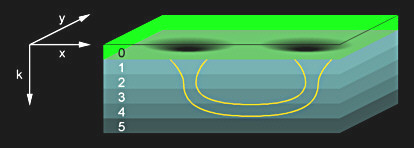
Fig. 3.11 Subspace channel
3.4 Subspace Technology
Not yet available.
3.5 Subspace Phenomena
Not yet available.
See Also
Power & Propulsion - about the right intermix ratio, warp inside a star system, how to stop a starship etc.






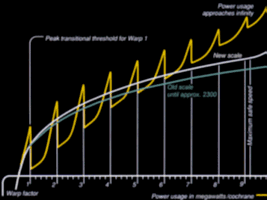
 Fig. 3.2 Peak transitional thresholds
Fig. 3.2 Peak transitional thresholds